Last Updated on March 15, 2025 by Alexx
Planning a Switzerland trip and want to know is the Glacier Express worth it? Here’s an honest review of my experience on the Glacier Express train, as well as some helpful Glacier Express tips and lots of photos from the trip to get you inspired.
Known as one of Europe’s most beautiful train journeys, Switzerland’s Glacier Express from Zermatt to St Moritz (or vice versa) tops bucket lists of travellers (and train nerds!) the world over. So when I decided to travel Europe by train for a few months during my solo round the world trip, I knew I had to include this panoramic train in my Switzerland itinerary!
The train trip offers some of the best and most varied scenery you’ll be able to get on a single train journey, including snowcapped mountains, glacial streams, charming alpine villages and more. But, like most things in Switzerland, it doesn’t come cheap! There is a way to get tickets for a significantly discounted rate though, I share all my secrets in this blog post so keep reading.
If you’re considering adding the Glacier Express train onto your Europe rail itinerary but keep asking yourself “is the Glacier Express worth it?”, you’ve come to the right place.
Here’s my detailed, honest review of the Glacier Express train, including all you need to know about booking your tickets, how to get a discount on the Glacier Express, where to sit, 1st class vs. 2nd class, and my final verdict on if the Glacier Express is worth it.
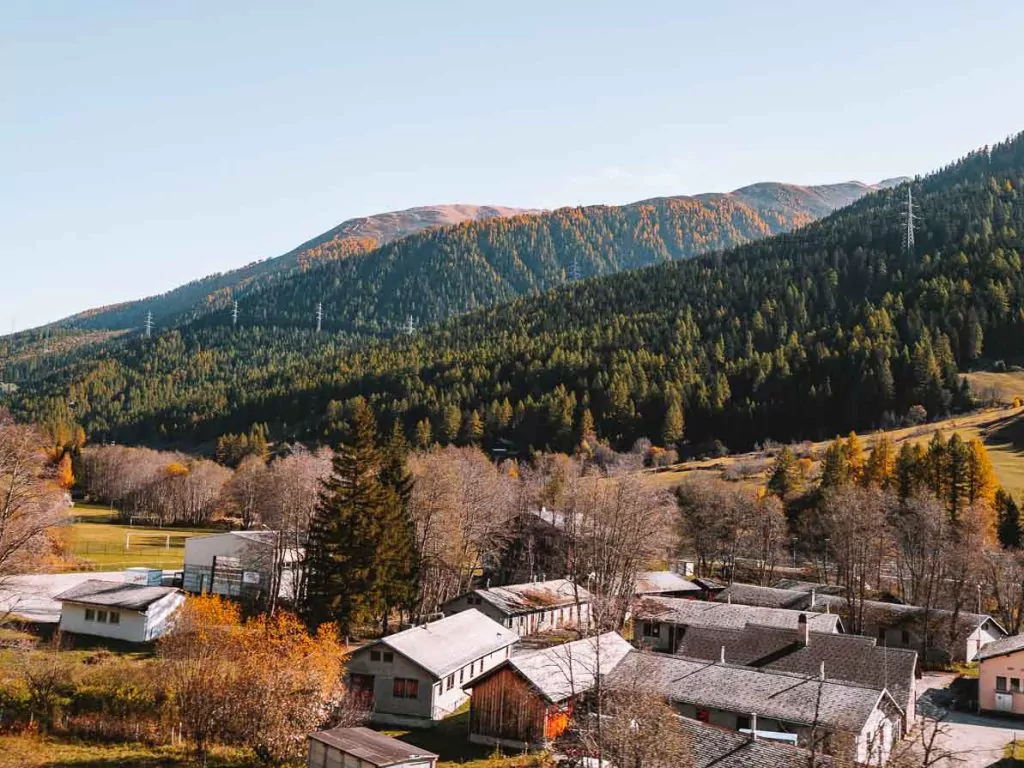
A summary: Is the Glacier Express worth it?
If you’re just here for the answer to that question, my answer is *probably yes*.
If you are a lover of mountain landscapes, if you’re a train enthusiast, if you have a day to spare in your itinerary to enjoy a slow journey, and/or if you have a Eurail, Interrail or Swiss Travel Pass giving you a massive discount, then the Glacier Express is likely going to be worth it for you.
If you’re the type of traveller who prefers active adventures rather than slow scenery, if you’re on a very tight budget, if you would need to travel out of your way to get there, or if you are running short on time, then the Glacier Express journey probably isn’t worth it for you.
I hope that gives you the answer to your question, but please read on for a more detailed explanation!
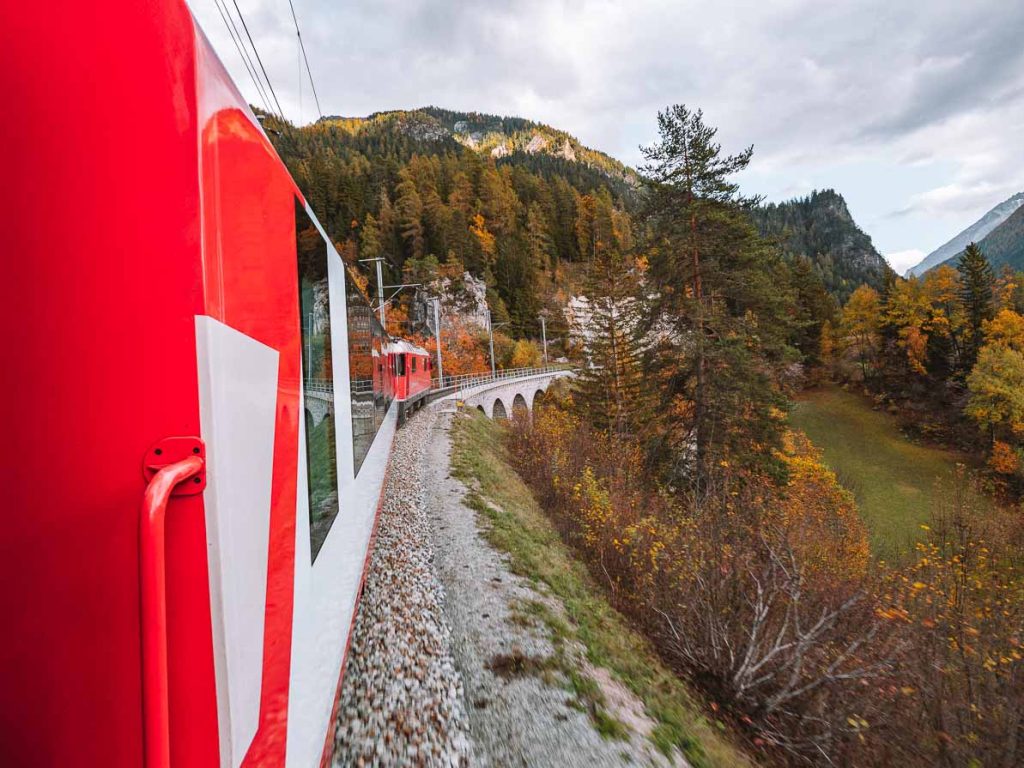
Glacier Express quick links
- Buy Glacier Express tickets/seat reservations here
- Buy your Eurail pass here
- Or buy a Swiss Travel Pass here
- Or a Swiss Half Fare Card Here
- Not sure which one you want? Check out my full guides (with example itineraries + calculations): Swiss Travel Pass Guide & Swiss Half Fare Card Guide, or a comparison of both
- My top hotel recommendation in Zermatt is the stunning Hotel ZERMAMA, one of my all-time favourite boutique hotels I’ve ever stayed in
- And for St Moritz I recommend Randolin’s Berghotel, I stayed in their incredible observatory which was a once-in-a-lifetime accommodation experience
- Want help with your itinerary? I’ve got a five day Switzerland itinerary, 10 day Switzerland itinerary and a Northern Italy and Switzerland itinerary with different length options
What is the Glacier Express?
The Glacier Express is an eight hour train journey around mountains and through gorges in the Swiss Alps. The trip takes you over 291 bridges and through 91 tunnels, allowing travellers to soak up the views through panoramic windows while relaxing on the luxurious train.
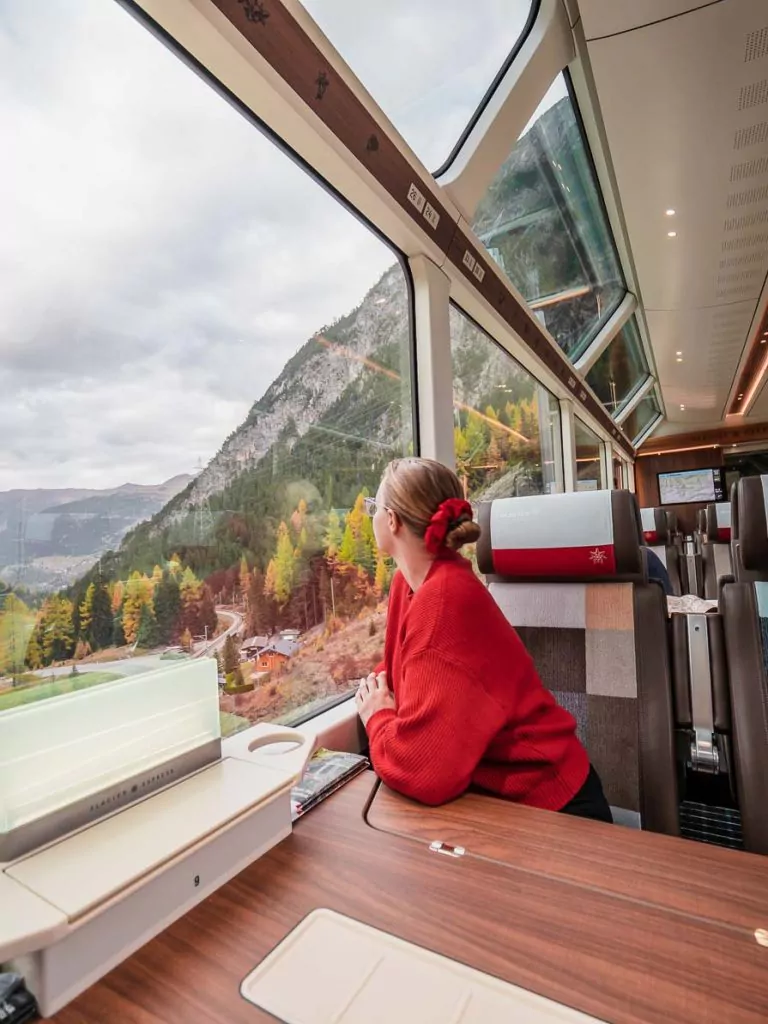
Where does the Glacier Express start and finish?
The full Glacier Express journey starts in Zermatt and ends in St Moritz, or vice versa. There are other stations in between where you can start or end your journey if you prefer.
Chur is a popular stop because that’s one of the starting points for another panorama train, the Bernina Express which runs to Tirano. The Bernina Express also has a train that runs from St Moritz to Tirano, so you could either spend a night at Chur or a night in St Moritz as your connect between the Glacier Express and Bernina Express.
👉🏼 Want to know more about the Bernina Express? I’ve got a detailed blog to let you know if the Bernina Express is worth it.
I’d recommend spending some time either side of the train journey if you are able to.
Zermatt travel tips
Where to stay in Zermatt
Quick note: The decent accommodation options in Zermatt book up many months in advance, and the budget options are few and far between, so book as early as you can to ensure you don’t miss out on something within your price range.
Budget
- Hotel Bahnhof (right by the train station, kitchen facilities, comfortable dorms and private rooms)
- Annex Antika (simple, affordable rooms but with access to the wellness area + free buffet breakfast at the Antika Hotel next door)
- Zermatt Youth Hostel (very basic but one of the cheapest places in Zermatt without compromising on cleanliness or comfort)
Mid-range
- Carina Design&Lifestyle Hotel (probably the most expensive dorm rooms I’ve ever seen haha but the hotel/hostel is absolutely beautiful!)
- Hotel Jägerhof (traditional 3* chalet with an excellent restaurant)
- Resort La Ginabelle (great value 4* hotel with access to wellness facilities)
Luxury
- I stayed at Hotel ZERMAMA, a brilliant boutique hotel which has firmly secured its spot as one of the coolest places I’ve ever stayed. Their interior design is just beautiful, with tones and materials that connect it to the mountains while also feeling stylish and modern, and some of the rooms have Matterhorn views.
- The Omnia (top-rated 5* hotel with world-class service and a lush spa complex)
- Riffelalp Resort (5* ski-in ski-out resort sitting at 2222m, with mind-blowing Matterhorn views)
- CERVO Mountain Resort (5* après ski haven with a focus on health, wellness and community)
Things to do in Zermatt
- See the Matterhorn (warning: you’ll crave a Toblerone immediately)
- Hit the slopes at the Matterhorn Ski Paradise, Europe’s highest-altitude ski area, open year-round
- Take the Gornergratbahn for the best view in Zermatt
- Hike the Five Lakes Walk
- Take the cable car to the highest cable car station in Europe, Matterhorn Glacier Paradise, for insane views and an epic ice palace experience
- Eat fondue (highly recommend doing so on your balcony at Hotel ZERMAMA, they have DIY fondue kits for guests to use!)
- Take a helicopter tour for an unforgettable aerial view of the Matterhorn and the Swiss Alps
- Relax in one of Zermatt’s luxurious spas, unwinding with views of the majestic alpine landscape
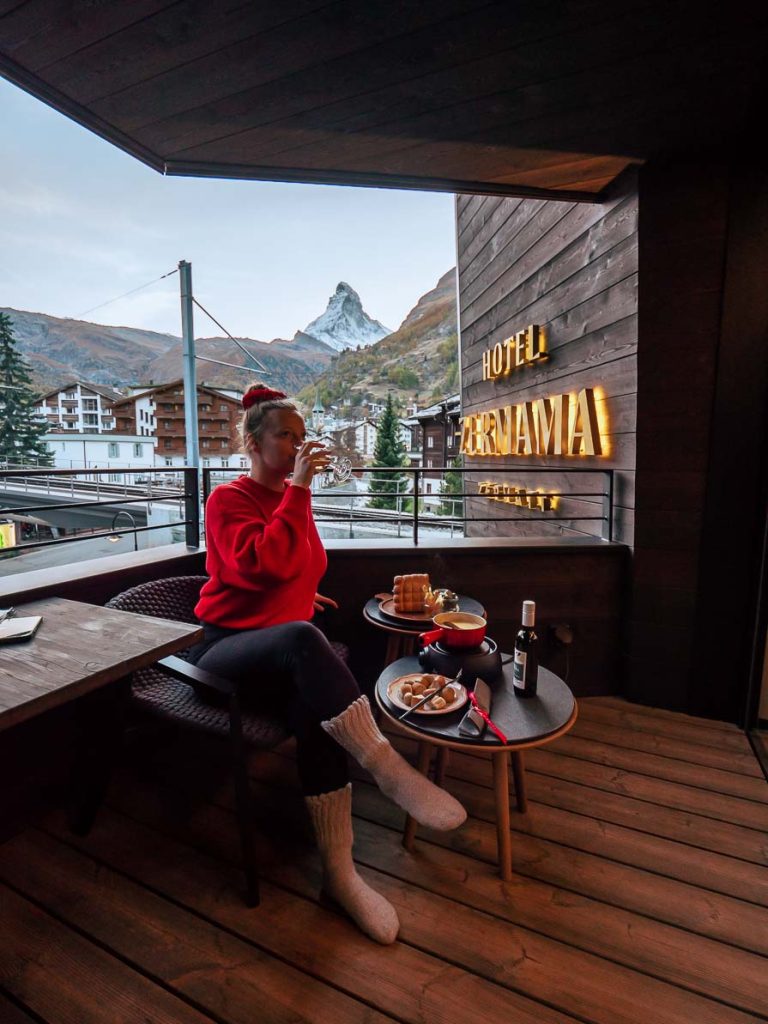
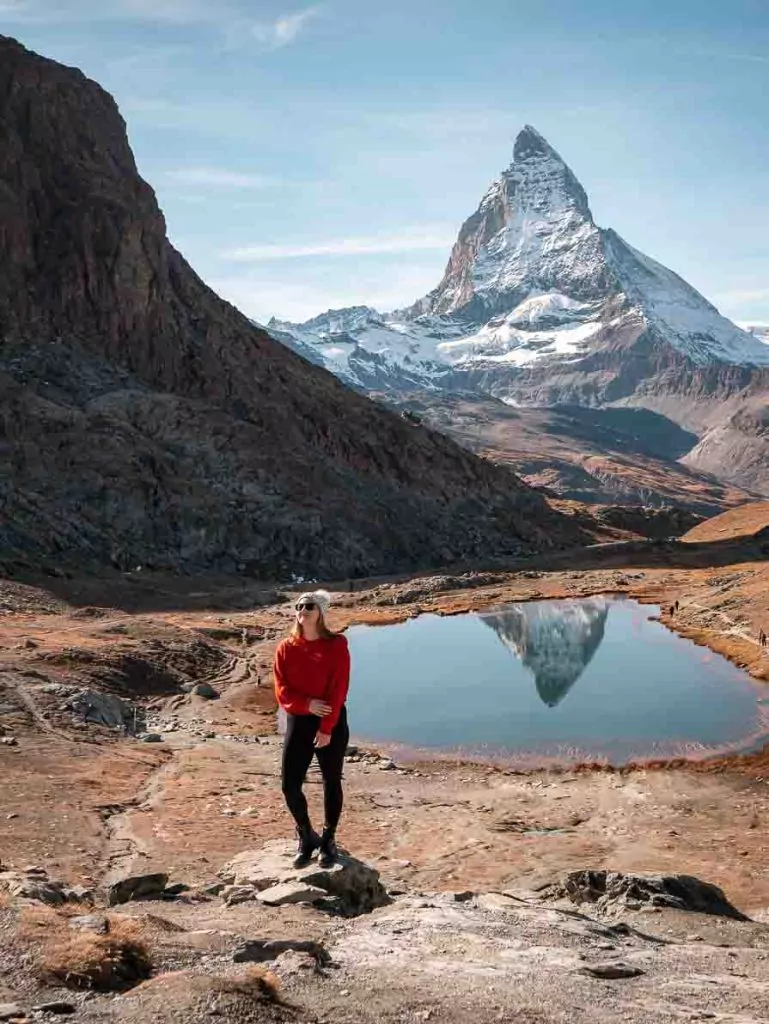
St Moritz travel tips
Where to stay | I stayed at Randolin’s Berghotel, which is a fantastic value family-friendly hotel with mountain and lake views. But that’s not all, I actually stayed in their historic observatory, complete with a turning mechanism and a window that opens for stargazing!
This observatory is SO COOL, one of the most unique places to stay in Europe. You have to climb up a ladder to get up to the dome, where you’ll find a cosy double bed, some bench space for sitting or storage, and a big heater keeping you warm all night long. The room has a private bathroom downstairs as well as a minifridge and kettle before climbing up the ladder.
The hotel’s facilities are great too, with a decent buffet breakfast, a shuttle bus into town (it’s a 30 minute walk otherwise) and an awesome wellness area with saunas, steam rooms and both an indoor and outdoor pool.
What to do | St Moritz is one of Europe’s most luxurious ski resorts in winter, with world-class runs, Michelin-starred restaurants and designer shops. In summer there are a range of cable car options to get you to epic viewpoints and hiking trails through the mountains.
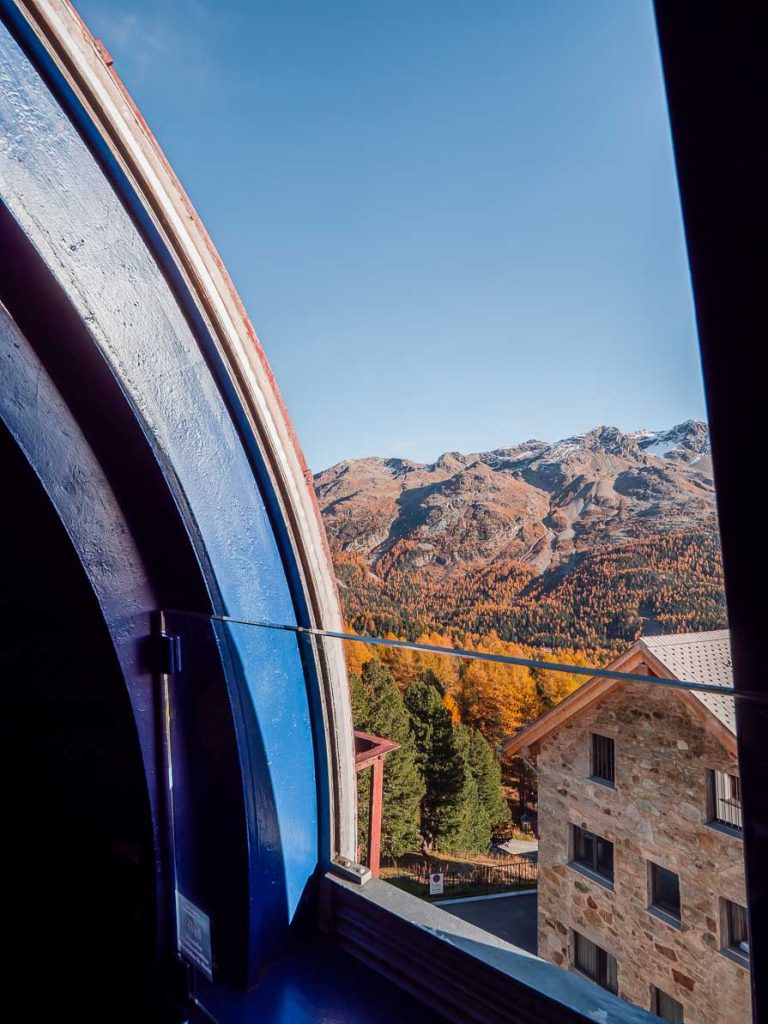
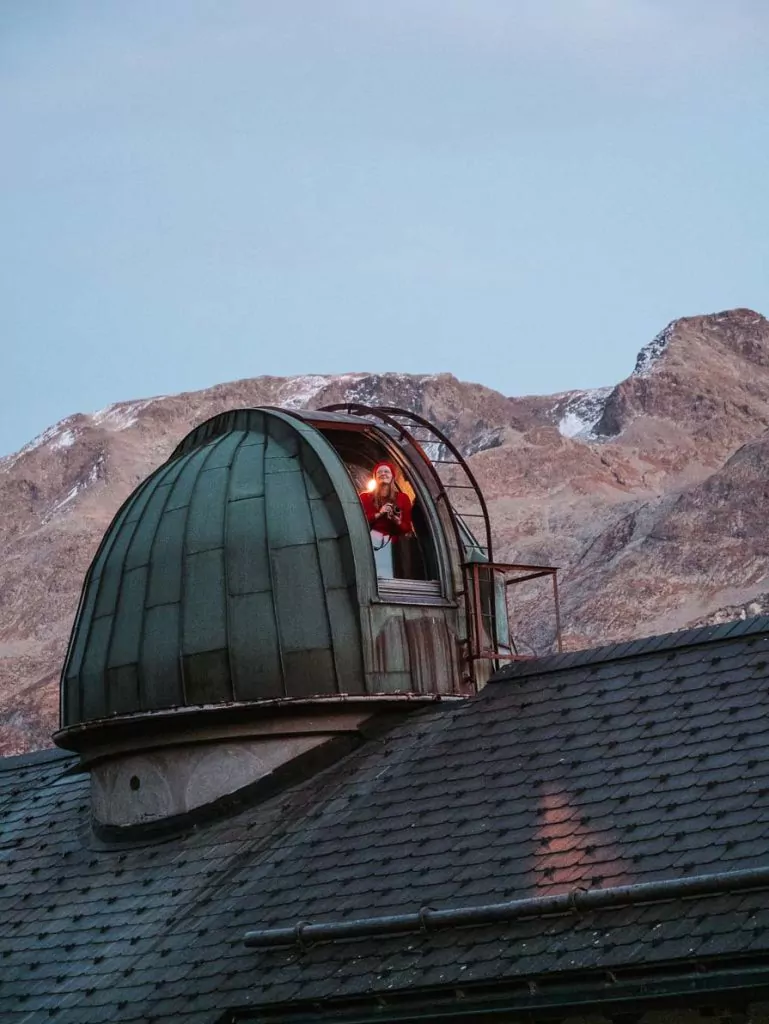
Want to extend your Glacier Express adventure? The Grand Train Tour of Switzerland is an eight-segment 1280km journey that ticks off Zurich, Interlaken, Montreux, Zermatt, St Moritz, Lugano, Lucerne and St Gallen. Phew! You’ll need at least 10 days in Switzerland for this one but ideally 12-15 days.
Glacier Express price: What do Glacier Express tickets cost?
Prices are valid as of 15 March 2025, check on the Glacier Express website for current prices.
Glacier Express tickets are made up of two separate payments, one for your ticket and one for your seat reservation.
The ticket price for the full journey from St Moritz to Zermatt (or the other way round) is 159CHF for 2nd class and 272CHF for 1st class, and ticket prices are the same regardless of the time of year you’re travelling.
In addition to this, there is a mandatory seat reservation fee, it used to change depending on the season but in 2024 they made it a bit simpler and have a single price year-round.
For the full route the seat reservation is 49CHF per person, and for a ‘short journey’ (if you’re not going the whole way between Zermatt to St Moritz) it’s 44CHF per person.
This means the full price you can expect to pay for the whole route is as follows:
2nd class: 208CHF (about €215*)
1st class: 321CHF (€332)
*Currency exchange to Euros is based on the rate as of 15 Mar 2025
If you aren’t taking the full journey and want to get off or hop on at one of the stations in between Zermatt and St Moritz, you can get slightly cheaper tickets and seat reservations.
See the full pricing info for the Glacier Express >>
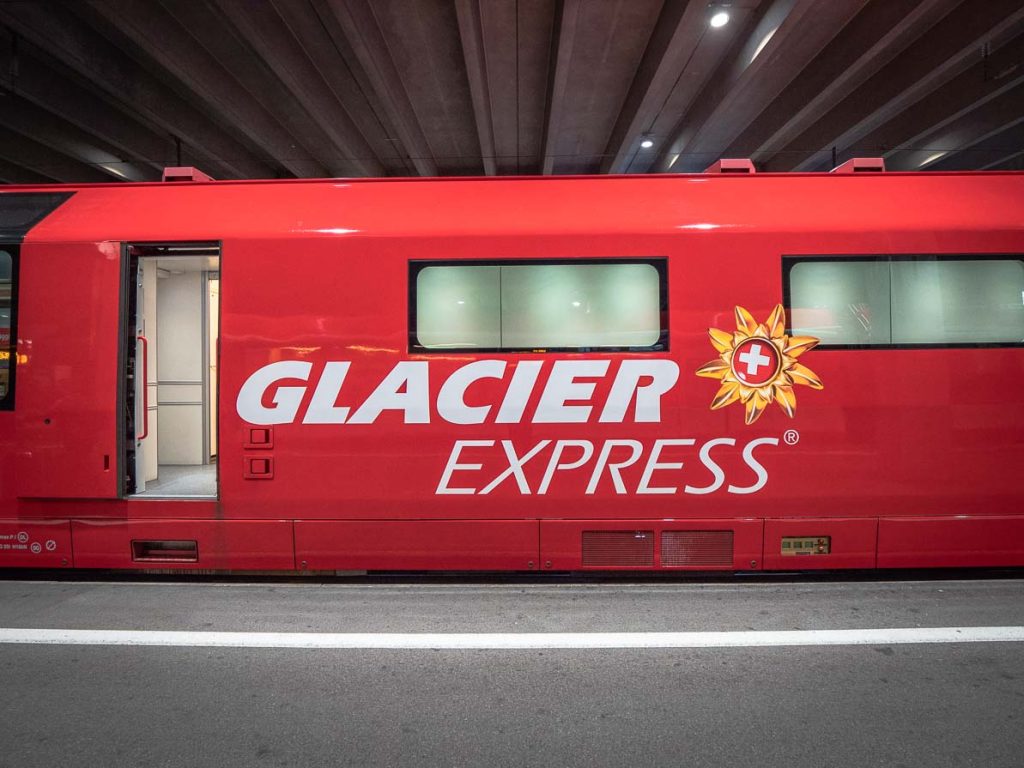
Can you get a Glacier Express discount?
I know those prices are pretty crazy but don’t click away yet! There’s a super easy way to get a HUGE discount on your Glacier Express tickets.
If you are planning on taking more than one train during your Switzerland or Europe adventures, you should look into getting a rail pass or travel pass.
What is a rail pass?
A rail pass generally covers the cost of train tickets for a specific period of time, either for a specific country or for multiple countries. In Switzerland there are some ‘travel passes’ on offer that include all public transport, not just trains.
I travelled with a Eurail Global Pass, which covers the cost of train tickets in 33 countries across Europe. Eurail passes are only valid for non-European citizens, if you live in Europe then you’ll need to get an Interrail pass which provides all the same benefits as Eurail.
If you’re travelling in Switzerland only (or if you want to combine a Eurail Pass and Switzerland travel pass to get discounts on other forms of transport in the country), you can choose from a Swiss Travel Pass which covers the ticket cost, or the cheaper Swiss Half Fare Card which gives you a 50% discount on the ticket price.
If you use a travel pass to cover or discount your ticket, you still need to pay for the mandatory seat reservation.
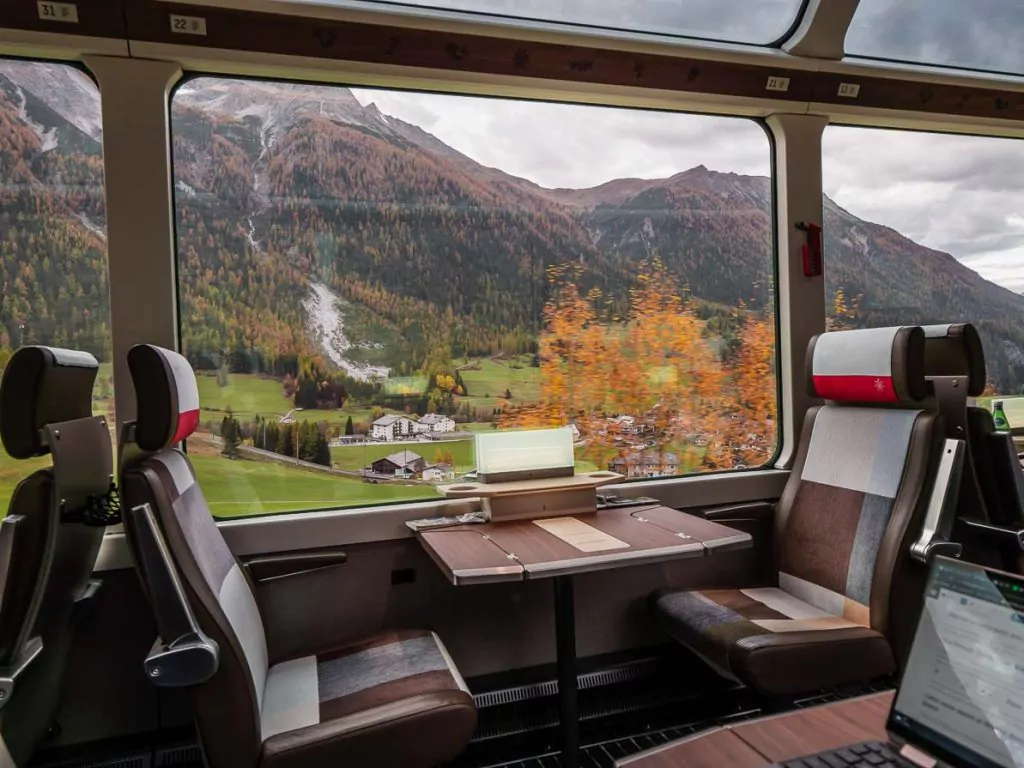
How much is the Glacier Express with a Eurail pass?
I’m glad you asked!
With a Eurail pass (or any other pass that covers the ticket cost), you’ll only need to pay for the seat reservation, which is 49CHF. That’s a discount of 159CHF in 2nd class or 272CHF in 1st class.
Rail passes of course have their own cost, and the most simple way to calculate if they’re worth it is to divide the pass cost by the number of travel days it gives you to give you a ‘daily cost’. As a quick example, my ’15 travel days in two months’ Eurail Global Pass in 1st class was worth €617 on my first Eurail trip in 2022. This means each of those travel days essentially ‘cost’ €41.33.
If I use one of my travel days for the Glacier Express at a ‘cost’ of €41.33, then have to pay for the seat reservation of 49CHF (€49.84 at the time), my total ‘cost’ for the Glacier Express is €91.17, instead of paying the full price of €322.20 for a 1st class ticket in high season in 2022. That’s still a huge saving of €231.03 when you take into account the price of the Eurail pass!
Eurail has a range of passes, from Global passes to single countries, flexible travel days to consecutive passes, 2nd class or 1st class, as well as cheaper passes for youths (27 & under) and seniors (60+), and the Eurail world can be a bit confusing if you’re new to it.
I got my Eurail pass from Rail Europe and they’ve been excellent to deal with, a very helpful team and quick to respond to my questions when I was first getting the hang of the pass.
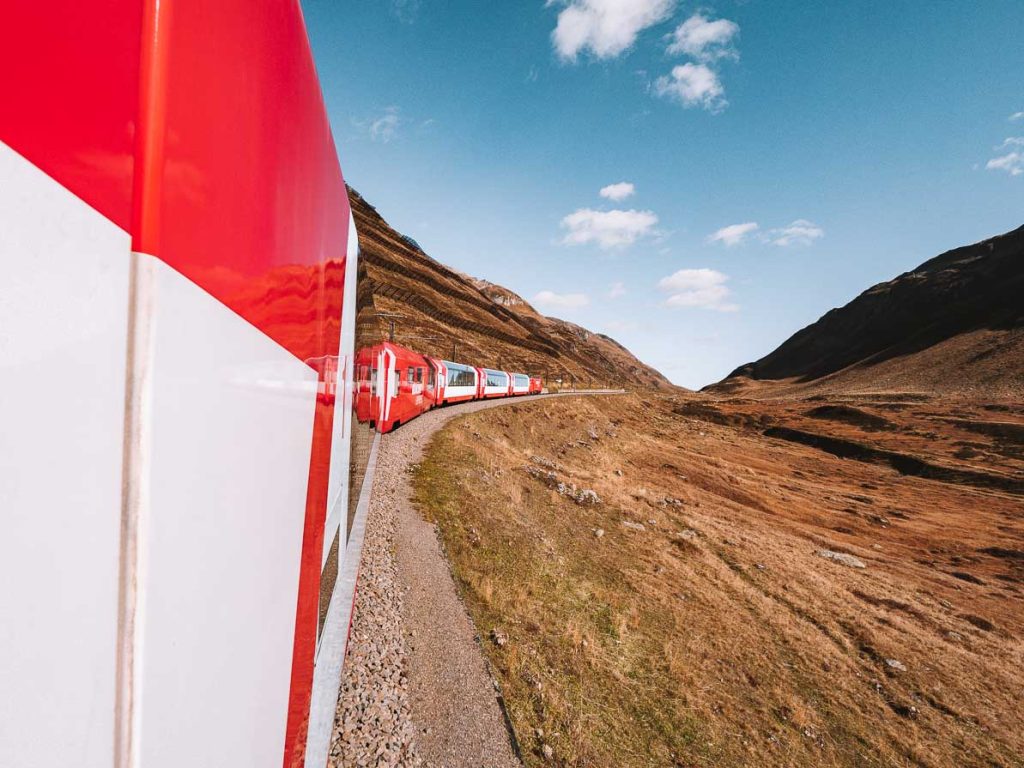
Can you use a Saver Day Pass on the Glacier Express?
If you don’t have a rail pass or travel pass, one way to save loads on the Glacier Express is to get a Saver Day Pass.
A Saver Day Pass is a ticket option from SBB (the official Swiss transport operator) that is essentially a one-day Swiss Travel Pass, giving you unlimited access to the Swiss Travel System on a particular day.
The Saver Day Passes range in price depending on availability, you can get them for as cheap as 52CHF if you book six months in advance (the earliest you can buy them) or if you wait until the last minute they’re around 100-119CHF. That’s still a decent discount on the price of 159CHF for the full Glacier Express trip. If you combine the Saver Day Pass with a Half Fare Card you can get them for even cheaper, not quite half price but can be a 15-45% discount depending on demand).
With the Saver Day Pass you’ll need to still make and pay for a seat reservation, and the Saver Day Pass isn’t refundable or changeable, so only buy it once you know your definite Glacier Express travel date.
How do you buy Glacier Express tickets?
To purchase Glacier Express tickets or seat reservations, you need to buy them on the Glacier Express website.
Tickets are only available for purchase 60 days before travel, but you can pay for your seat reservation (and lock in your seat) three months in advance. Super weird, don’t ask me why, I don’t make the rules. Seat reservations do get booked up in advance, particularly in summer when the July/August period can sell out the day they are released, so set a reminder for three months ahead of your departure date to check for reservations.
Put your departure/origin, travel date and chosen class into the search bar, then click ‘next’. It’ll take you to the availability calendar where it’ll show you how many seats are available on the trains that day and three days either side.

Once you click on a date, it’ll bring up the train layout and show you the available seats for you to choose one (I’ll let you know where to sit in the next section of this blog). At this stage it’ll show the full price (ticket included) but if you have a rail pass you’ll be able to add that in the next step.
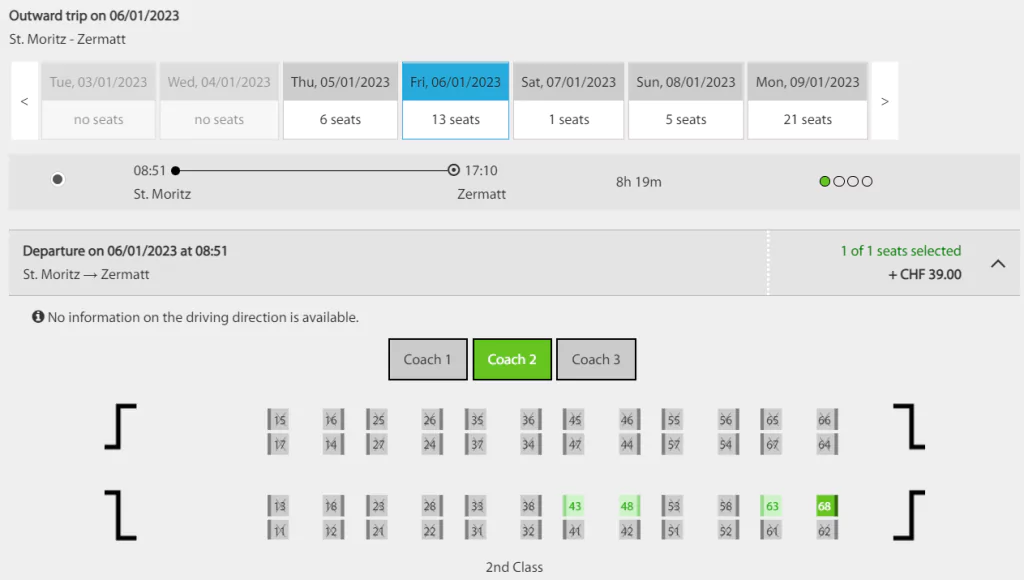
Add all your information into the traveller info section, then in the ‘Reduction’ dropdown you’ll be able to choose Eurail/Interrail Pass, Swiss Travel Pass or Swiss Half Fare Pass which will discount the price.
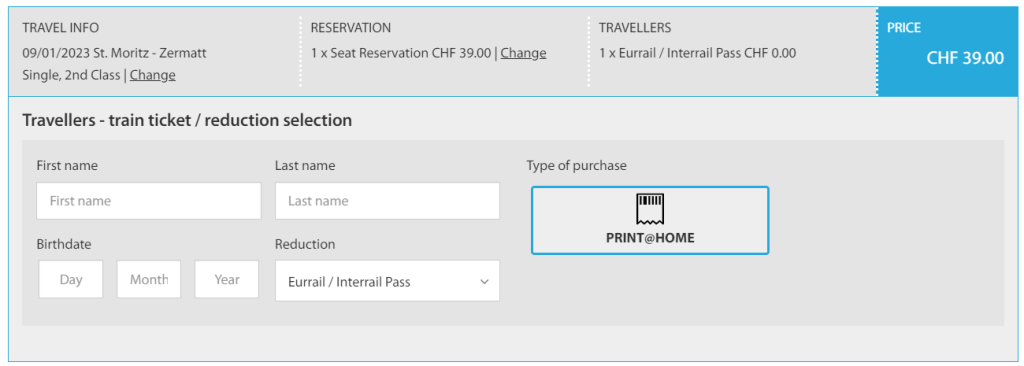
On the next page it’ll ask you if you want to add a meal, you can do this now if you know you want food but they also have a menu you can order from on the train itself so no need to pre-book if you aren’t sure.
Which side of the Glacier Express should you sit on?
The seat layout image does say ‘no information on the driving direction is available’ and they say this for two reasons.
Firstly, the train actually enters Chur going one way and then starts driving in the other direction, so you’ll switch sides after that station. Secondly, the train company says that the train compartments might change for different trips so they can’t guarantee that the ‘top’ or ‘bottom’ seats on the image will definitely be on a particular side.
In saying that though, from chatting to a few Glacier Express frequent riders, it seems as though the seats you want are generally the ones on the same side as the single column of seats in first class, which are at the ‘bottom’ of the image in the booking system at the time of my most recent update (Mar 2025)*.
These seats are typically on the right side for most of the trip (until Chur) when going from Zermatt to St Moritz, and the left side for most of the trip (after Chur) from St Moritz to Zermatt.
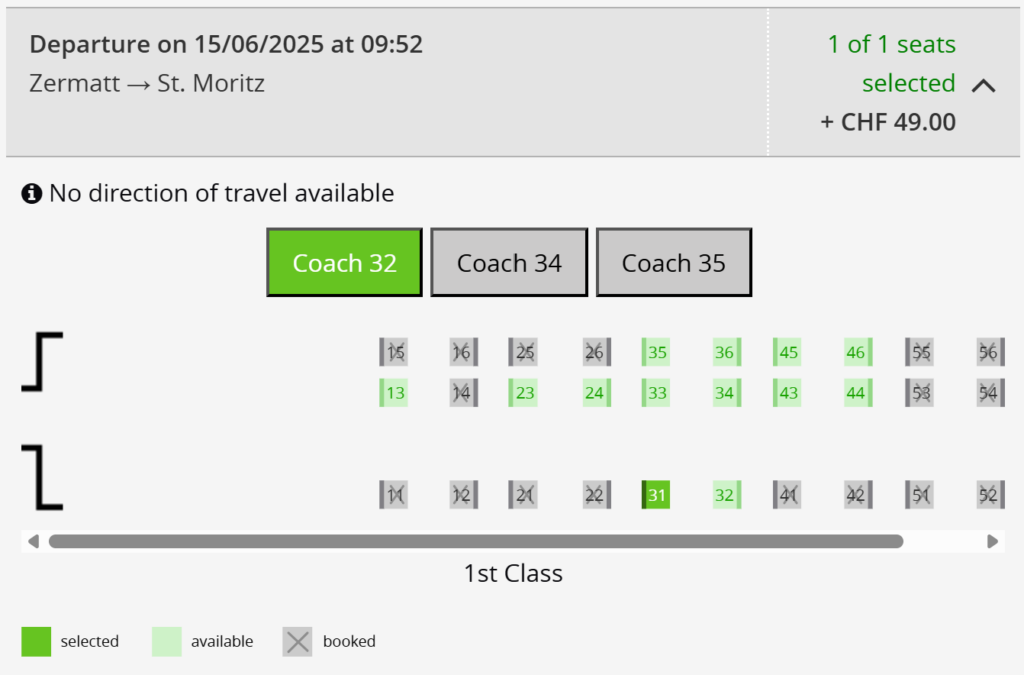
*You can check if the single column of seats is still being shown as the ‘bottom’ seats on the booking system by just clicking through the coaches and finding the first class coach.
Sitting in these ‘bottom’ seats gives you the best views of almost all the best scenery, except for one notable sight on the other side, the Landwasser Viaduct. If this is an absolute must-see for you then I’d recommend choosing a seat from the ‘top’ row of the image, otherwise just make sure you’re standing by the window at the end of the carriage to get photos of the viaduct. Which brings me to…
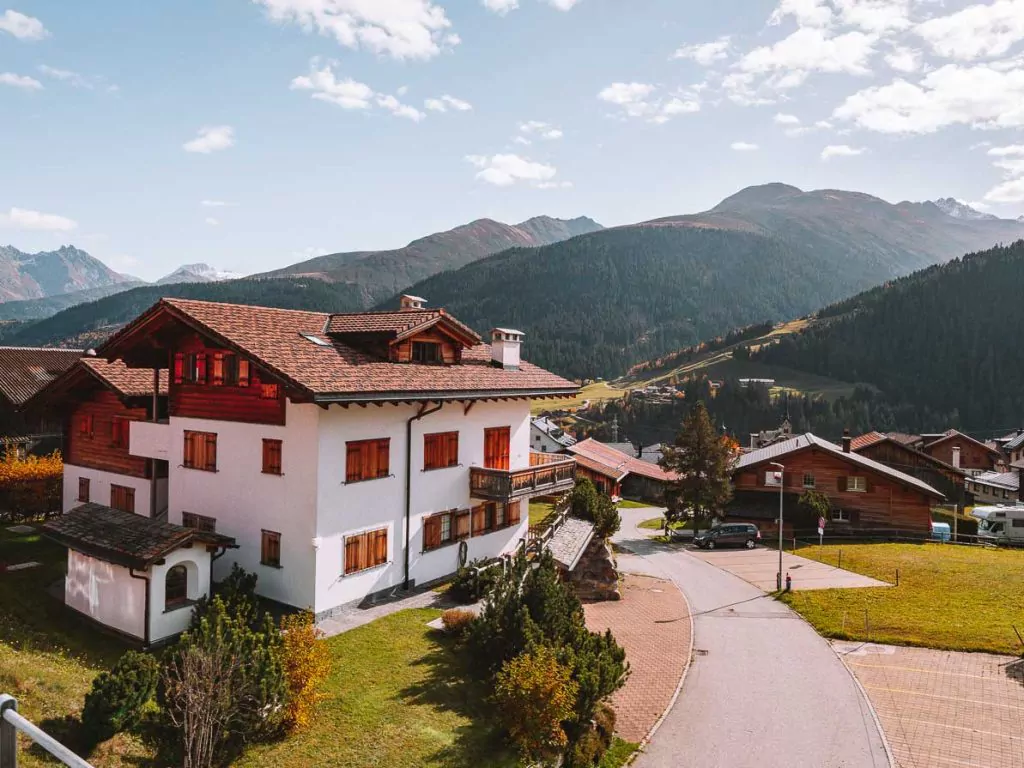
How can you take the best photos on the Glacier Express?
I hate to be the bearer of bad news, but the Glacier Express is less than ideal for photography due to huge un-open-able windows and terrible reflections. Photos hardly do the views any justice!
The best way to capture photos from the Glacier Express is to open the windows of the doors at the end of each cabin, these will give you a glass-free viewpoint with no reflections. Just be very careful for obvious reasons and don’t lean out too far, the train gets super close to trees/posts/tunnel walls and you don’t want to lose your phone, camera or a limb.
If you’re determined to shoot from your seat, here are a few simple tips to help you get the best photos:
- Use a polarising filter on your camera
- Use a lens hood and get as close to the glass as possible
- Wear dark clothing, bright clothes will be more obvious in reflections
- Have a dark scarf with you to wrap around your phone/lens
- Shoot from the less sunny side of the train
- Use a high shutter speed as the train will be moving at about 38km/h
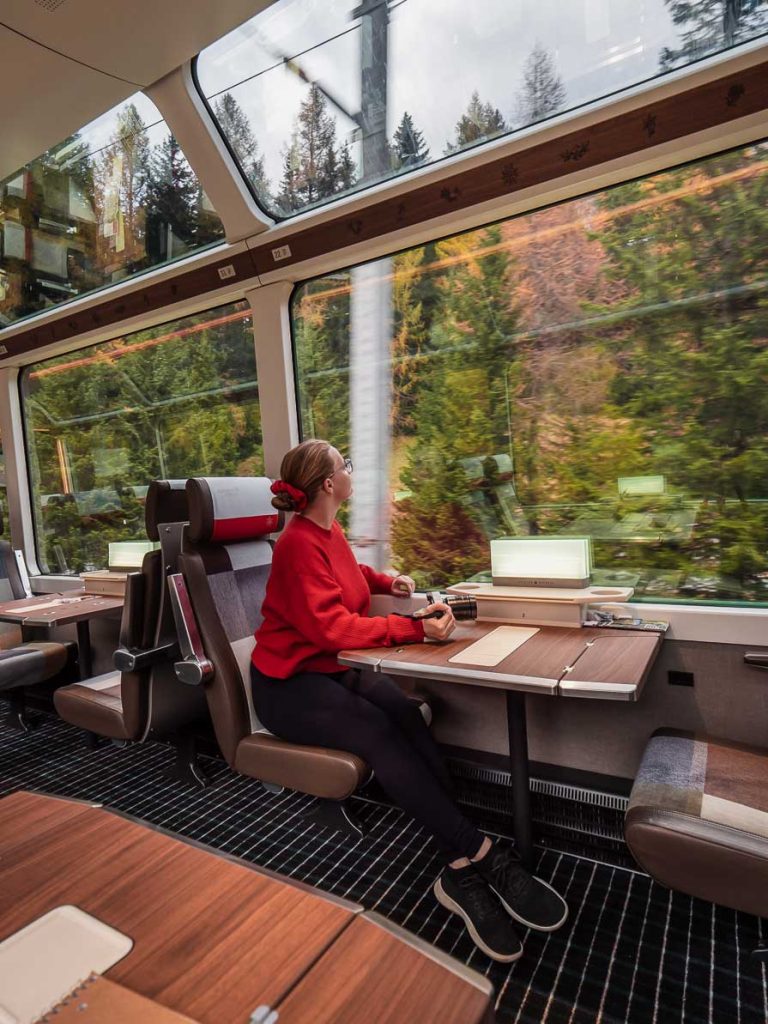
Glacier Express 1st Class vs. 2nd Class
I had a 1st class Eurail pass so I booked a 1st class seat, but I had a wander into the 2nd class cabin to check it out too.
The main benefit of a 1st class ticket is that there’s additional space.
The seat layout is 2-2 on one side and 1-1 on the other side (vs. 2-2 and 2-2 in 2nd class) which means slightly bigger seats and a bigger aisle. Having 1-1 seats is also ideal for a couple/duo or solo travellers, because you can have your own spot without having to scoot past someone else to get out of your seat.
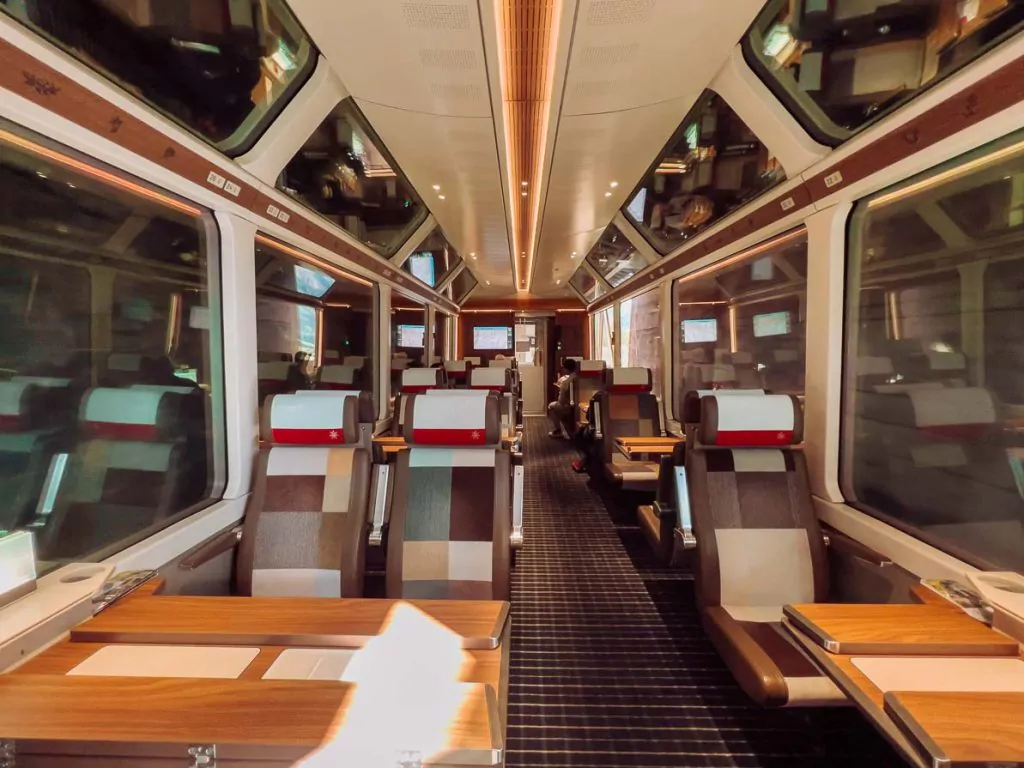
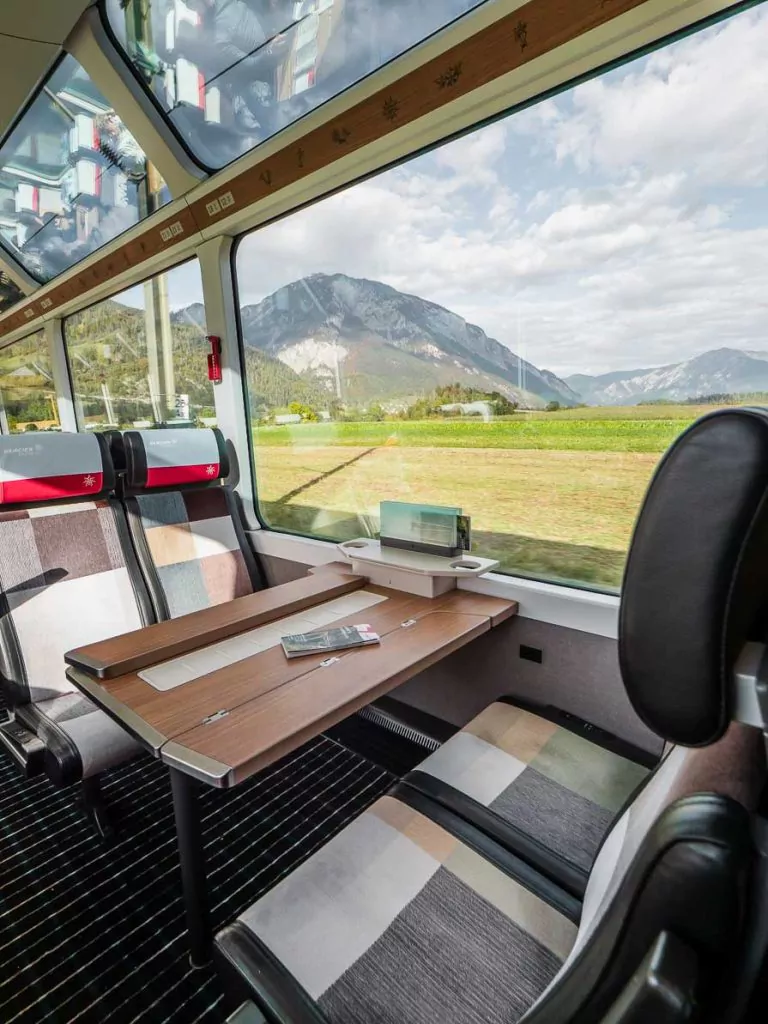
Apart from that, basically everything else is the same. The panoramic windows are the same, the menu is the same, both 1st class and 2nd class have speedy WiFi, and the views are obviously the same. I usually go for the first class upgrade on trains because more space means it’s easier to work on my laptop, but for the Glacier Express I was too busy enjoying the scenery to do any laptop work anyway!
If you’re paying for your ticket outright I’m not sure it’s worth an additional 116CHF (ouch) to upgrade to first class, unless you specifically want to take advantage of the 1-1 seating configuration.
But if you are tossing up between a 1st class vs 2nd class Eurail Pass, I’m a firm believer that 1st class is worth it if you are planning on doing at least a couple of long-haul journeys. The extra space makes trips significantly more comfortable and it’s a must if you plan on working while on trains.
What about Glacier Express Excellence Class?
If you’re celebrating something special, or if you just feel the need to splurge on a once in a lifetime experience, Glacier Express has an ultra-luxurious Excellence Class option at a cool 470CHF for the seat reservation on top of a 1st class ticket.
For the full St Moritz to Zermatt journey that’s 470+272, so 742CHF, which is equivalent to about €793. Yikes!
Excellence Class is certainly something to write home about though. It has a 1-1 and 1-1 seat configuration so you’ve got a guaranteed (and comfortable) window seat, concierges who help with luggage and anything else you need, access to an exclusive bar onboard and top quality catering and drinks.
Your Excellence Class reservation includes a six course meal using regional ingredients, accompanying wines, coffee, juice, champagne, afternoon tea, soft drinks and snacks throughout the trip.
Is Glacier Express Excellence Class worth the 742CHF cost? I’m leaning towards a no, but I guess if you had the money to spare and were celebrating something like a honeymoon or a special birthday then perhaps you could justify it!
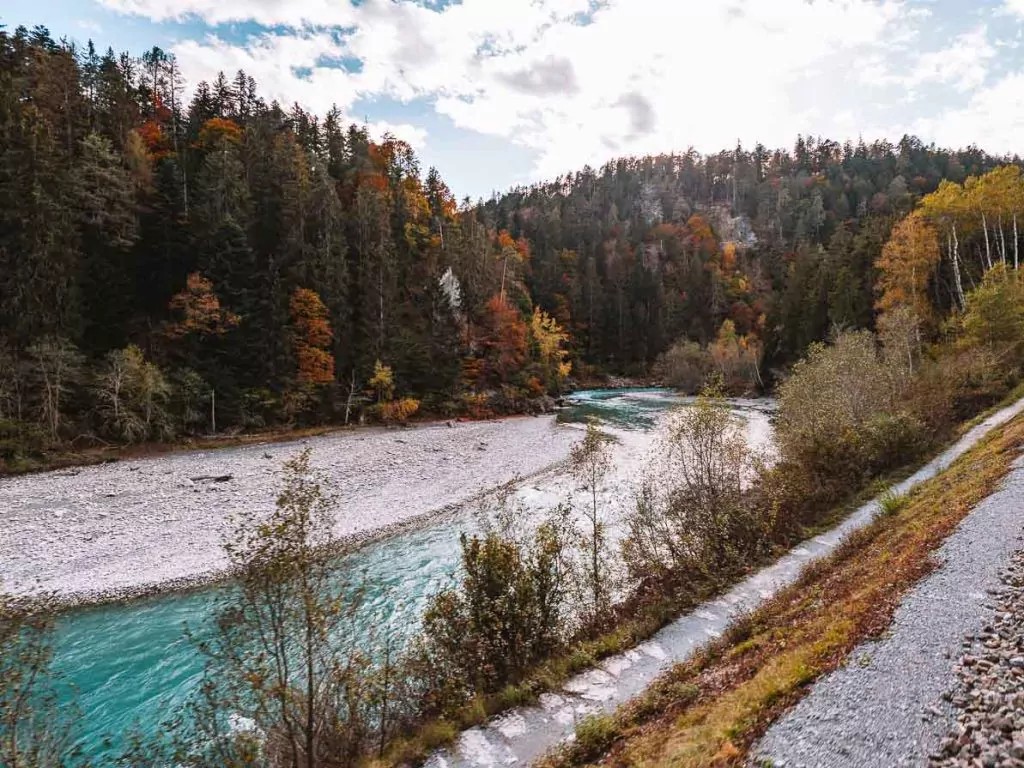
Does the Glacier Express run year-round?
No, the Glacier Express does not run year-round, it has a break from late October to mid-December.
This almost caught me out because the actual Glacier Express contradicts this and says that it’s been running all year since 1982, so I planned out my itinerary to include the train trip in early November 2022. When I went to book I realised that there was in fact a shutdown period from 24 October, and had to completely rejig my trip to fit it in a few days before it closed for the season. Phew!
In 2025 the seasons are as follows:
Winter: 7 December 2024 to 2 May 2025
Summer: 3 May to 11 October 2025
Shutdown period: 12 October to 5 December 2025
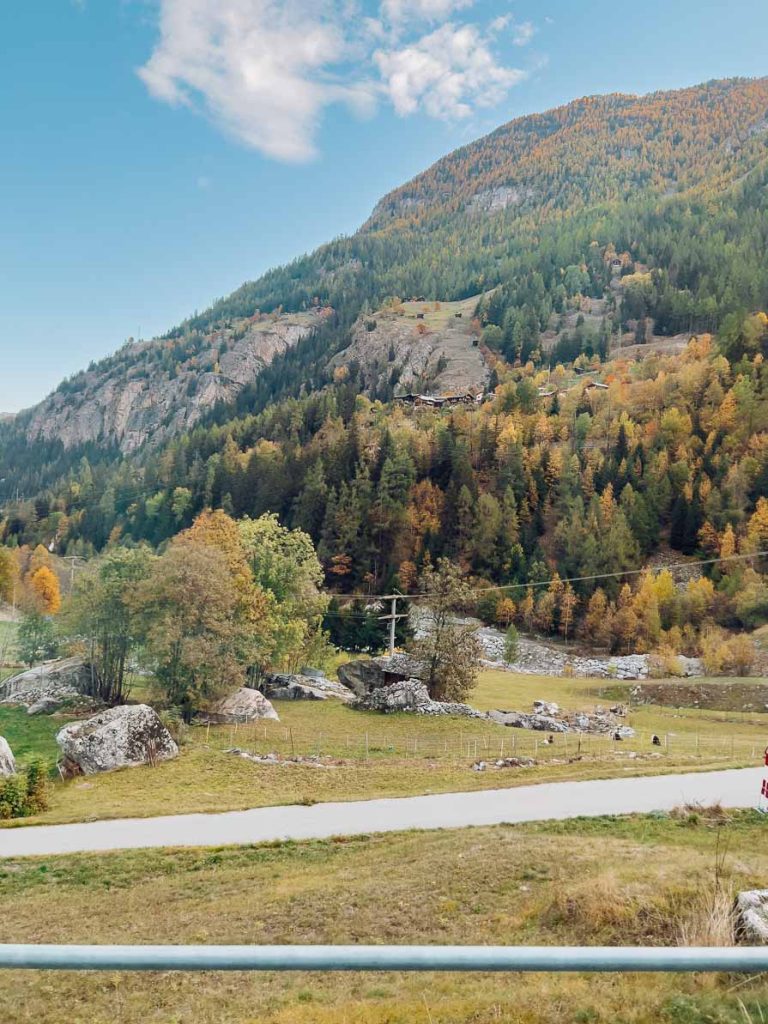
Can you take luggage on the Glacier Express?
Of course you can! There are dedicated storage racks at the end of each cabin for big suitcases, and you can keep smaller bags under your seat or in between seats if there is room.
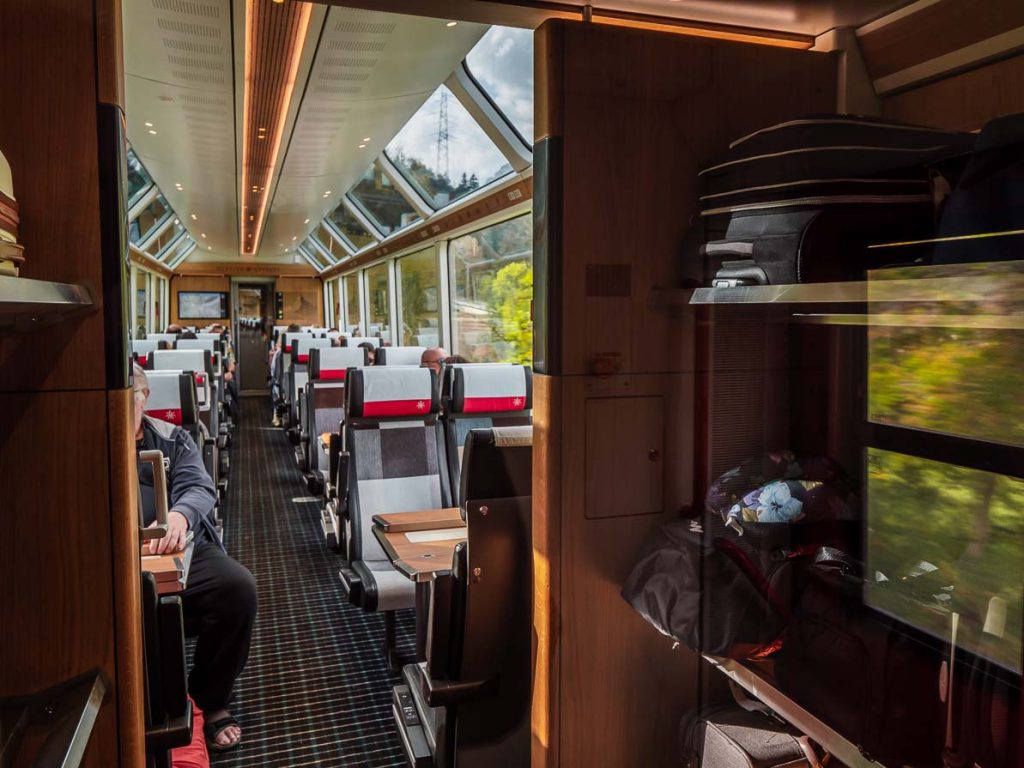
Can you do the Glacier Express route on local trains?
If your travel dates are already full for the Glacier Express, or if you just want to keep it cheap and cheerful, the good news is that you can travel the same route as the Glacier Express by local trains, but the trip does include four train changes.
If you’re travelling with a Swiss Travel Pass or a Eurail pass, these local non-express trains are included in your pass with no seat reservations needed, so it’ll be totally free.
I haven’t done this on the local trains myself, but to find the correct local trains you can go to the SBB website (the national railway company), put ‘Zermatt’ as your origin, ‘St. Moritz’ as your destination, and add ‘Disentis/Mustér’ in the optional ‘Via’ box, then click ‘search for connection’.

The local train option takes 8h 23m with four changes in Visp, Andermatt, Disentis/Mustér and Reichenau-Tamins. Two of the connections are quite short (5 mins and 8 mins) but with a rail pass you can just jump on any local Swiss train, so if you are running too tight for the next train you can take it easy and wait for the next one instead.
These local trains don’t have the same panoramic windows as the official Glacier Express, but from my experience all Swiss trains are clean and comfortable so you’ll still enjoy the journey.
The verdict: Is the Glacier Express worth it?
I absolutely loved my trip on the Glacier Express, and for me it was definitely worth it.
If you have a Eurail Pass or Swiss Travel Pass, the Glacier Express is basically a no-brainer because it’s such a huge discount, you’re getting incredible value for money when you only have to pay the seat reservation fee.
If you don’t have a rail pass and are planning on buying your ticket outright, then the Glacier Express will be worth it for you if you’re really passionate about landscape scenery, if it’s been on your bucket list for a long time, or if you’re able to spend the money and time without too much worry.
And if you’re on a really tight budget but don’t mind the hassle of switching trains, consider taking the local train route instead.
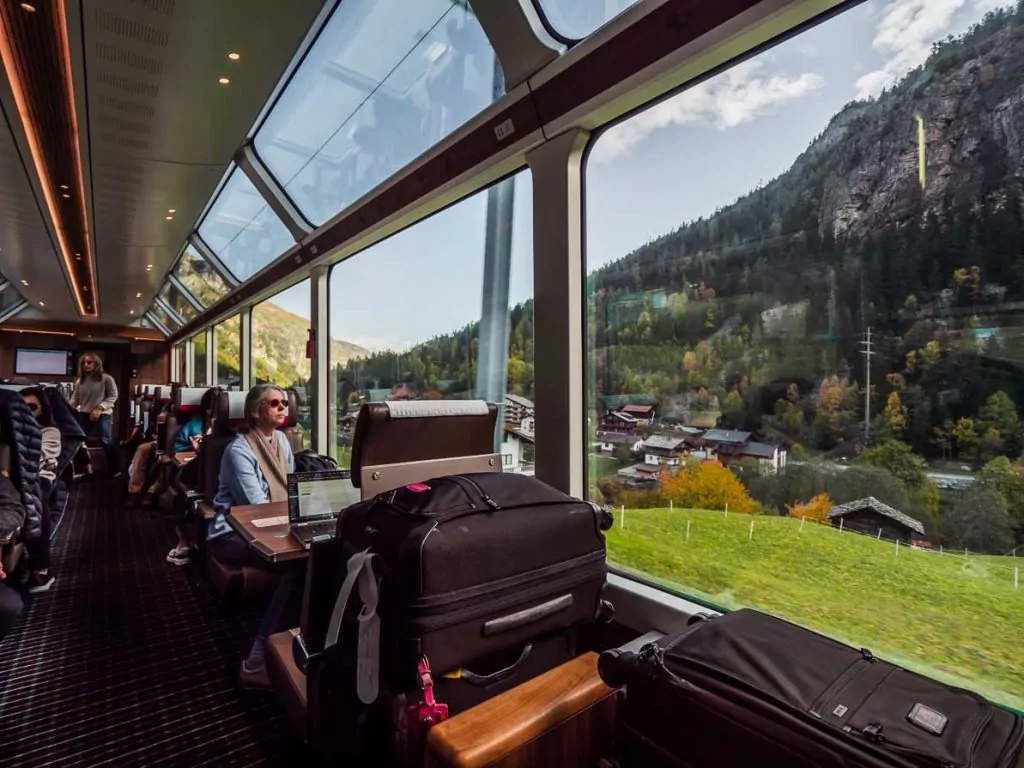
I hope this blog has helped you answer the question “is the Glacier Express worth it?”! If you have any other Glacier Express questions, or general Europe rail questions for that matter, let me know in the comments and I’ll do my best to get back to you.
For more photos and videos of my Glacier Express trip you can head over to my Instagram and scroll through my highlights to find the ‘Switzerland’ highlight, which has details all about my trip day by day.
MORE SWITZERLAND TRAVEL INSPIRATION:
- How to spend 10 days in Switzerland
- How to spend 5 days in Switzerland
- 33 Instagrammable places in Switzerland
- Rigi vs Pilatus vs Titlis vs Stanserhorn: Which one to visit?
- The cheapest place to ski in Switzerland: Liddes Ski Hostel
- 10 reasons to try co-living in Switzerland
MORE SWITZERLAND TRAIN GUIDES:
- Swiss Travel Pass vs Half Fare Card: Which one is best?
- The ultimate Swiss Travel Pass guide
- The ultimate Swiss Half Fare Card guide
- Is the Bernina Express worth it?
- Bernina Express vs Glacier Express: Which one should you choose?
- Is the Jungfrau Travel Pass worth it?
- Is the Tell Pass worth it?
MORE EUROPE TRAVEL INSPIRATION:
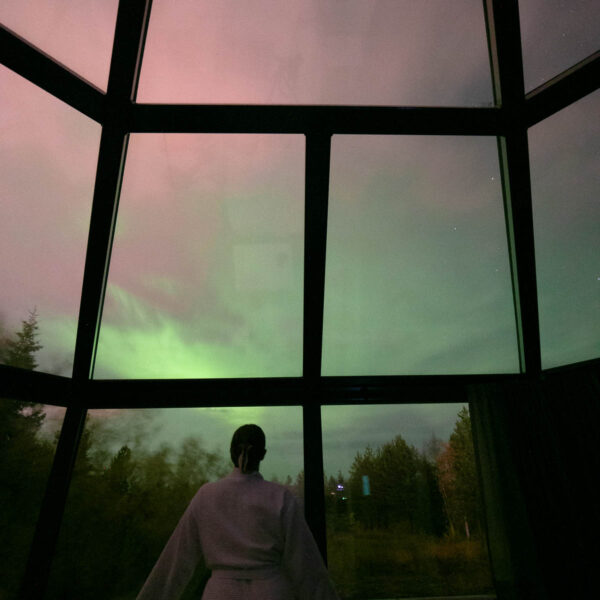
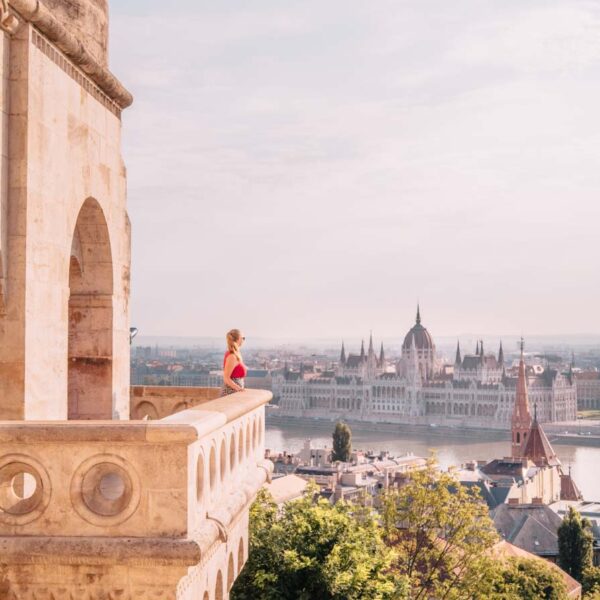

This is honestly sooooo helpful, every question I thought of was answered in this blog 😁😁
If you think of anything else just flick me a message gal 🙂 you guys will have the best time!
It was very helpful, Thank you .
I want to go the 16.5.2023 with the train from Bratislava.SK to St.Moritz or to Chur,and then with the Glacier expres to Zermatt.
I don`t know exactly how i should do that,without loozing tíme.
I would like to ser something nice in 8 days.
I som little bit older lady,but with great sense to explore.
Daška
Glad it was helpful! To get from Bratislava to Chur you can take the train (or bus might be cheaper) to Vienna and spend some time there if you wish, then it’s a one-stop (in Buchs) train to Chur from Vienna 🙂
Thank you fór the tip about the train from Vienna. I know Vienna very Well.
I consider about to go to Zermatt oné day to Gornergrat.
Second to Montreux and Lousane (spend there night),to Geneva,the samé dať to Bern sleeping there,než dať to Lucern sleeping there.With the Boat to Rigi.Sleeping in Lucerne,train to Zürich,then back to Bratislava .
Second plán:
Zermatt,then Bern,then Lucerne,Lugano,Locarno ,Ascona,,Locarno, Zürich.
Byt i think the first idea IS better.Don`t you think?
Thank you very múch fór your respond.
Unfortunately I haven’t been to Bern, Lugano, Ascona or Locarno so I can’t really say which option is better, but the first option including Montreux, Lausanne and Geneva is what I would choose!
Thank you very múch ,Wish you Nice days,
Daska
Great information! If we take a shorter ride on the Glacier Express from Chur (instead of San Moritz) to Zermatt, would we regret missing that part of the ride between San Moritz and Chur? Is it especially beautiful?
You would miss the Landwasser Viaduct between St Moritz and Chur which is very cool to see, but the entire trip is beautiful so I don’t think you’d be disappointed with the shorter Chur to Zermatt route!
Hello. How would we get from st .moritz to Geneva.
Lots of train options, you could go St Moritz to Chur, Chur to Zurich and Zurich to Geneva for example.
So much wonderful information and a real time saver from doing extensive and confusing research. Thank you for being so informative.
I’m glad it’s helped Paul, thank you for your kind words 🙂
THinking of taking glacier express from Chur to St Mortiz, do you think it will be worth it and will give us good experience of the landscape?
Hey Nick! Both the Bernina Express and the Glacier Express travel between Chur and St Moritz (the Bernina stops at Samedan which is a very short regional train to St Moritz) and the Bernina Express is much cheaper than the Glacier so that is something to consider. My personal favourite views are between Zermatt and Chur as you wind through the most beautiful valleys, but if you only have time for Chur to St Moritz then you’ll still get some stunning mountain villages, tunnels, viaducts and more!
Hi Alexx,
Thanks for the detail information on Glacier express. I have a few questions regarding Switzerland in general. Appreciate if you can respond.
1. In September end, we will be travelling to Switzerland with whole family including a senior. Do you recommend not taking her to Jungfraujoch due to the altitude? Did you see many seniors during your trip there?
2. In the small towns like Interlaken, Lauterbrunnen and Zermatt, how is the local transport if we want to look around using a vehicle rather than walking and hiking? Can we hire taxis in those places? Are there local buses?
3. Given a choice between Interlaken, Lauterbrunnen, Zermatt etc where do you recommend staying overnight? We are planning to enter Switzerland via Zurich, stay a few days at Lucerne and then eventually make our way through to Zermatt for glacier express. Where do you think would be a good place to make a halt before that but still managing to see those towns?
4. Do the Swiss railway stations happen to have luggage rooms to drop off and later pick up our luggage?
Thanks in advance.
Hi Chan! No problem, happy to help.
1. I saw tour groups that had seniors with them but this would probably be best to ask a physician as it would totally depend on her health and fitness in general. 2. Interlaken has taxis and buses, Lauterbrunnen is much smaller and more mountainous so you’d mostly get around by cable car/mountain trains, Zermatt is a no-car village but there are small electric taxis which can take you around.
3. I’d say Interlaken would be best for an overnight stay for you, you can take an easy day trip to Lauterbrunnen from there as well as explore the lakes and viewpoints around Interlaken itself. Then do at least one night in Zermatt before the Glacier Express, going up the Gornergrat is my top must-do in Zermatt.
4. All of the railway stations I went to have luggage lockers which you can pay for, usually 8-12CHF for a big locker for a day.
Happy travels!
HI Alexx,
I am planning my travel on Gracier Express between Zermatt to Aldermatt, is it worth it?
I got a 2 year old and I would like to keep it short and sweet
The view is incredible from start to finish on the Glacier Express so I’d say it would still be worth it!
If you had to choose between the Glacier Express and the Bernina Express, which would you choose?
I’ve actually got a full blog post on that: https://findingalexx.com/bernina-express-vs-glacier-express/
If you’re limited on time and/or money then the Bernina offers better value and it’s a shorter trip, but if you have a Eurail Pass or Swiss Travel Pass and you have enough time for a full day thing, the Glacier Express is seriously spectacular!
Halo Alexx,
I am Chin here, would like to plan a trip to Switerland 3 weeks.
Base 10 days Zurich and 14 days in Bern.
I will be using Swiss Pass Flex 15 days for my trip.
I need your kind advise as I would like to do Glacier and Bernina Express, since I have time for both.
Anyway, this is my 1st time in Europe.
My spouse is vey tall and big built (6 feet 3, so siting at 2nd class a bit small or 1st class seat will be better?
So you have done Glacier Express ………………… 8 hours?
Zermatt to St Moritz
Chur to Tirano
Your help would be appreciated. thank you very much
We both above 60 years old.
regards
ching
Hi Ching 🙂 If you want to do both the Glacier Express and the Bernina Express you won’t be able to do them from Zurich or Basel, you’ll need to spend at least a couple of nights outside of those cities. I’ve got some itineraries that might help:
https://findingalexx.com/10-day-switzerland-itinerary/
https://findingalexx.com/northern-italy-switzerland-itinerary/
I’d definitely recommend a first class pass for a tall person, worth the upgrade!
Hi Alexx,
thank you for your advice and king suggestion.
We will read thru your itinearies you provide, many thanks
I decide to do a day trip from Zurich, Chur to Tirano (4 hours) Bernina Express
From Bern, Zermatt to St Mortiz (Glacier Express 8 hours) stay 2 nights at St Moritz, return trip by normal trian.
Actually we not keen to do a 8 hour journey trip, after reading your blog, we decide to go for it.
We will take your advice to upgrade to first class seat for husband to sit more comfortable.
As and when I got time will read up your blog for more information.
Have a great day ahead.
Regards
Ching
Hi. I take it it is one way and not a return journey? thank you!
Yep the Glacier Express is generally a one way journey, but you could do it return and just take the second leg the next day
Do you need to buy the Swiss Travel Pass before you purchase your Glacier Express Tickets?
You don’t need the Swiss Travel Pass when you purchase your seat reservation, you just need to make sure you have a valid pass on the day of travel as this functions as your ticket.
Does glacier express also have allegra units as they are in Bernina express?
The Glacier Express train itself doesn’t have any unreserved carriages, but you could cover that route using regional trains with a few train changes if you don’t mind the logistics and want to save money!
I purchased two tickets for the Glacier Express yesterday and received an order number. The confirmation said that the order confirmation would be sent to you via email shortly…but I have not received anything. I did look and my credit card was charged yesterday.
For any booking/reservation questions you’ll need to get in touch with the Glacier Express team because I’m not 100% sure on how their system works. You can contact them at [email protected]
Thank you I will email them now.
Hi, when travelling in class 2 can I pass to see the bar in excellence class?
Unfortunately not, the Glacier Bar in Excellence Class is exclusive to Excellence Class guests only